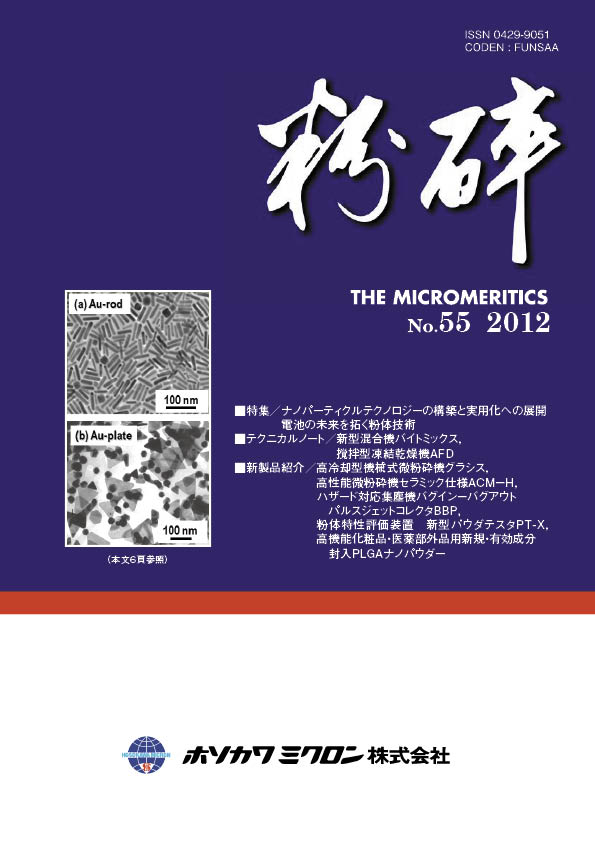Volume 55
Displaying 1-25 of 25 articles from this issue
- |<
- <
- 1
- >
- >|
Front Cover
-
2012Volume 55 Article ID: 2012001
Published: December 13, 2011
Released on J-STAGE: October 03, 2018
Download PDF (497K)
Foreword
-
2012Volume 55 Pages 1-2
Published: December 13, 2011
Released on J-STAGE: October 03, 2018
Download PDF (255K)
Special Subject I: Construction of Nanoparticle Technology and Evolution to Practical Realization
-
2012Volume 55 Pages 3-11
Published: December 13, 2011
Released on J-STAGE: October 03, 2018
Download PDF (2071K) -
2012Volume 55 Pages 12-18
Published: December 13, 2011
Released on J-STAGE: October 03, 2018
Download PDF (866K) -
2012Volume 55 Pages 19-25
Published: December 13, 2011
Released on J-STAGE: October 03, 2018
Download PDF (848K) -
2012Volume 55 Pages 26-31
Published: December 13, 2011
Released on J-STAGE: October 03, 2018
Download PDF (1120K) -
2012Volume 55 Pages 32-37
Published: December 13, 2011
Released on J-STAGE: October 03, 2018
Download PDF (745K) -
2012Volume 55 Pages 38-47
Published: December 13, 2011
Released on J-STAGE: October 03, 2018
Download PDF (1927K)
Special Subject II: Powder Technology Pioneers the Future of Batteries
-
2012Volume 55 Pages 48-53
Published: December 13, 2011
Released on J-STAGE: October 03, 2018
Download PDF (849K) -
2012Volume 55 Pages 54-57
Published: December 13, 2011
Released on J-STAGE: October 03, 2018
Download PDF (914K) -
2012Volume 55 Pages 58-62
Published: December 13, 2011
Released on J-STAGE: October 03, 2018
Download PDF (557K) -
2012Volume 55 Pages 63-70
Published: December 13, 2011
Released on J-STAGE: October 03, 2018
Download PDF (2074K)
Technical Note
-
2012Volume 55 Pages 71-73
Published: December 13, 2011
Released on J-STAGE: October 03, 2018
Download PDF (557K) -
2012Volume 55 Pages 74-76
Published: December 13, 2011
Released on J-STAGE: October 03, 2018
Download PDF (568K)
New Products
-
2012Volume 55 Pages 77-78
Published: December 13, 2011
Released on J-STAGE: October 03, 2018
Download PDF (680K) -
2012Volume 55 Pages 79-80
Published: December 13, 2011
Released on J-STAGE: October 03, 2018
Download PDF (463K) -
2012Volume 55 Pages 81-83
Published: December 13, 2011
Released on J-STAGE: October 03, 2018
Download PDF (569K) -
2012Volume 55 Pages 84-86
Published: December 13, 2011
Released on J-STAGE: October 03, 2018
Download PDF (603K) -
2012Volume 55 Pages 87-88
Published: December 13, 2011
Released on J-STAGE: October 03, 2018
Download PDF (610K)
Business Overview
-
2012Volume 55 Pages 89
Published: December 13, 2011
Released on J-STAGE: October 03, 2018
Download PDF (242K) -
2012Volume 55 Pages 90
Published: December 13, 2011
Released on J-STAGE: October 03, 2018
Download PDF (256K) -
2012Volume 55 Pages 91-92
Published: December 13, 2011
Released on J-STAGE: October 03, 2018
Download PDF (388K) -
2012Volume 55 Pages 93-94
Published: December 13, 2011
Released on J-STAGE: October 03, 2018
Download PDF (423K)
New Book
-
2012Volume 55 Pages 95
Published: December 13, 2011
Released on J-STAGE: October 03, 2018
Download PDF (213K)
Topics
-
2012Volume 55 Pages 96-98
Published: December 13, 2011
Released on J-STAGE: October 03, 2018
Download PDF (391K)
- |<
- <
- 1
- >
- >|
